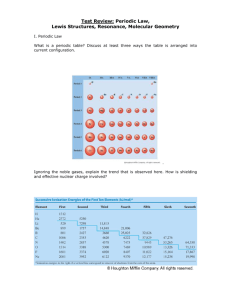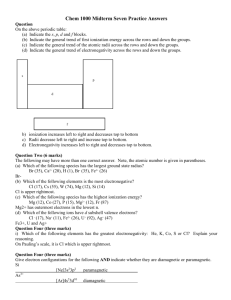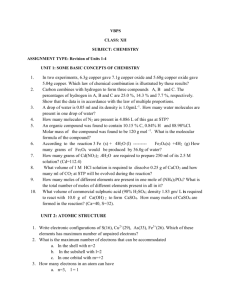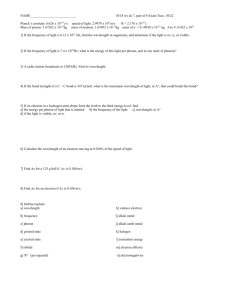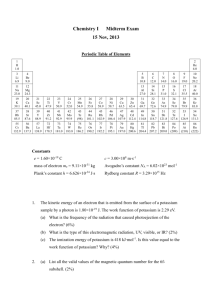Chapter 5 Kinetic Molecular Theory KEAVE and Average Velocity
advertisement
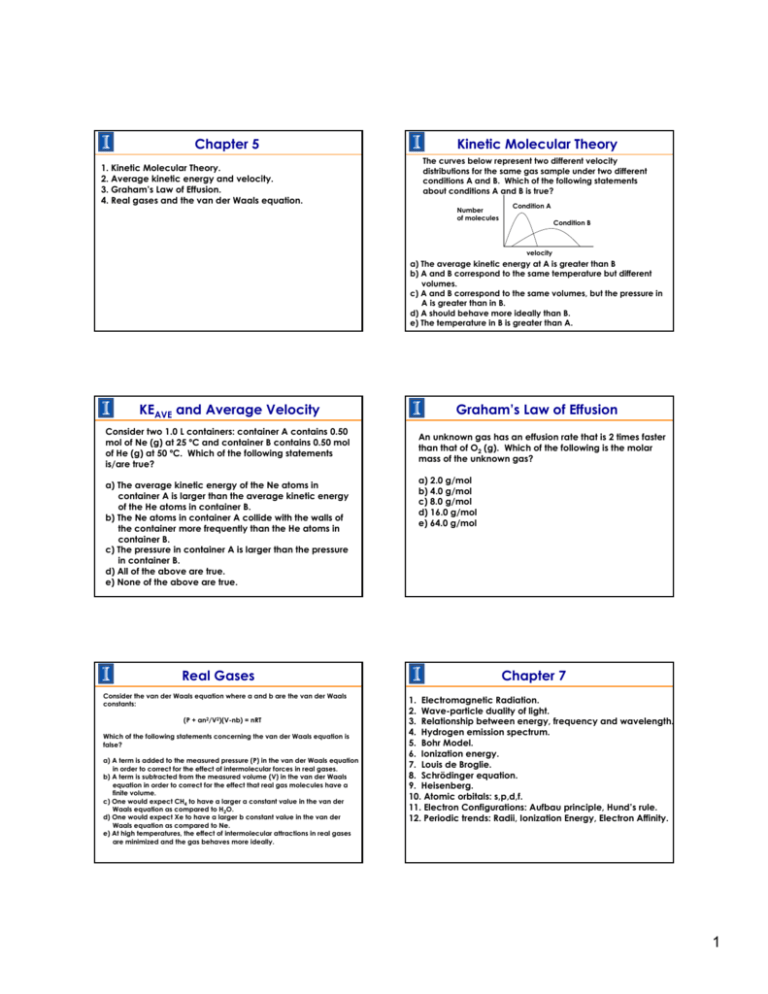
Chapter 5 1. Kinetic Molecular Theory. 2. Average kinetic energy and velocity. 3. Graham’s Law of Effusion. 4. Real gases and the van der Waals equation. Kinetic Molecular Theory The curves below represent two different velocity distributions for the same gas sample under two different conditions A and B. Which of the following statements about conditions A and B is true? Number of molecules Condition A Condition B velocity a) The average kinetic energy at A is greater than B b) A and B correspond to the same temperature but different volumes. c) A and B correspond to the same volumes, but the pressure in A is greater than in B. d) A should behave more ideally than B. e) The temperature in B is greater than A. KEAVE and Average Velocity Consider two 1.0 L containers: container A contains 0.50 mol of Ne (g) at 25 ºC and container B contains 0.50 mol of He (g) at 50 ºC. Which of the following statements is/are true? a) The average kinetic energy of the Ne atoms in container A is larger than the average kinetic energy of the He atoms in container B. b) The Ne atoms in container A collide with the walls of the container more frequently than the He atoms in container B. c) The pressure in container A is larger than the pressure in container B. d) All of the above are true. e) None of the above are true. Real Gases Consider the van der Waals equation where a and b are the van der Waals constants: (P + an2/V2)(V-nb) = nRT Which of the following statements concerning the van der Waals equation is false? a) A term is added to the measured pressure (P) in the van der Waals equation in order to correct for the effect of intermolecular forces in real gases. b) A term is subtracted from the measured volume (V) in the van der Waals equation in order to correct for the effect that real gas molecules have a finite volume. c) One would expect CH4 to have a larger a constant value in the van der Waals equation as compared to H2O. d) One would expect Xe to have a larger b constant value in the van der Waals equation as compared to Ne. e) At high temperatures, the effect of intermolecular attractions in real gases are minimized and the gas behaves more ideally. Graham’s Law of Effusion An unknown gas has an effusion rate that is 2 times faster than that of O2 (g). Which of the following is the molar mass of the unknown gas? a) 2.0 g/mol b) 4.0 g/mol c) 8.0 g/mol d) 16.0 g/mol e) 64.0 g/mol Chapter 7 1. Electromagnetic Radiation. 2. Wave-particle duality of light. 3. Relationship between energy, frequency and wavelength. 4. Hydrogen emission spectrum. 5. Bohr Model. 6. Ionization energy. 7. Louis de Broglie. 8. Schrödinger equation. 9. Heisenberg. 10. Atomic orbitals: s,p,d,f. 11. Electron Configurations: Aufbau principle, Hund’s rule. 12. Periodic trends: Radii, Ionization Energy, Electron Affinity. 1 Electromagnetic Radiation Wave numbers are another quantity that can be used to characterize electromagnetic radiation. Wave numbers are equal to the reciprocal of the wavelength (wave number = 1/λ). For electromagnetic radiation, as the wave number increases, the frequency (ν) ___________ and the photon energy (E) ___________. (Fill in the blanks with increases or decreases). Bohr Model Which aspect of the Bohr theory is not allowed by Heisenberg’s uncertainty principle? a) discrete atomic energy levels b) simple circular orbits c) deBroglie wavelengths d) atomic orbitals a) decreases; decreases b) decreases; increases c) increases; increases d) increases; decreases Quantum Mechanical Model Which of the following statements is false? a) The three 6p atomic orbitals have the same energy but they differ in their orientation about the x, y and z axes. b) 2d atomic orbitals do not exist in the quantum mechanical model of the atom. c) For neutral atoms, the 8s atomic orbital should be lower in energy than the 7d atomic orbitals. d) The dz2 atomic orbital has a unique shape as compared to the other 4 atomic orbitals. e) An excited state electron configuration for an atom represents a lower energy electron configuration as compared to the ground state electron configuration. Radii Trend Electron Configurations How many of the following are correct ground state electron configurations for the element or ion listed? Note element #118 is not yet discovered and Zr is element #40. Element #118: Zr: S2-: Cu+: [Rn]7s25f146d107p6 [Kr]5s24d2 [Ne]3s23p6 [Ar]4s23d8 a) 0 b) 1 c) 2 d) 3 e) 4 Ionization Energy Which of the following correctly orders the radius of the atoms/ions listed from the smallest to the largest radius? Which of the following statements is false concerning ionization energy? a) F<F+<Ca<Br<Rb-<Sr b) F<F+<Ca<Sr<Rb-<Br c) F+<F<Br<Ca<Rb-<Sr d) F+<F<Ca<Sr<Br<Rbe) F+<F<Br<Ca<Sr<Rb- a) The second ionization energy of Ne is greater than the first ionization of F. b) For an isoelectronic series, the species with the most protons should have the smallest ionization energy. c) As the size of an atom increases, ionization energy generally decreases. d) As the electronegativity of an atom increases, ionization energy generally increases. e) The third ionization energy for magnesium corresponds to the enthalpy change for the reaction: Mg2+ (g) → Mg3+(g) + e- ∆H = IE3 2 Electron Affinity Experiments show that an unknown element, X, has one unpaired electron in the ground state and has an exothermic electron affinity. Its most stable ion exhibited in ionic compounds is know to be isoelectronic with argon. Which of the following elements could be X? a) Na b) Cl c) Ca d) S e) Ga Chapter 8 1. 2. 3. 4. Chemical Bonding. Electronegativity. Drawing Lewis structures for ionic compounds. Drawing Lewis structures for covalent compounds that obey the octet rule. 5. Covalency rules for organic compounds. 6. Drawing Lewis Structures for compounds that do not obey the octet rule. 7. VSEPR 8. Predicting overall polarity of molecules. 9. Hybrid orbital theory. 10. Delocalization. Chemical Bonding Which of the following statement is false concerning bonding? Lewis Structures Which of the following will have the Lewis structure: 2- a) In a C-O bond, electron density on the average is greater near the O atom. b) A C-O bond is an example of a polar covalent bond. c) The bond in NaBr is formed from sharing electrons. d) Elements with extremely different electronegativity values tend to form ionic bonds with each other. e) An N-H bond is more polar than a P-H bond. X X a) B22b) C22c) N22d) O22e) F22- VSEPR VSEPR How many of the following molecules have a square planar shape? Which of the following molecules have at least one 90º bond angle in their structure as predicted by the VSEPR model? KrF4, PCl5, XeO4, TeF4, ICl3 a) 1 b) 2 c) 3 d) 4 e) 5 a) H-C-C-H b) H-C-N c) F-O-F d) H-C-H O e) None of the above How many of the above molecules have at least one bond where the atoms cannot freely rotate unless a bond is broken? (a) 0 (b) 1 (c) 2 (d) 3 (e) 4 3 Molecular Polarity Hybrid Orbital Theory DNA molecules are complex organic compounds found in every living cell which act as the information and control centers for the cell. Part of any DNA molecule is the organic compound guanine which has the following O skeletal structure: How many of the following five compounds are polar? CF4, SF4, KrCl2, PCl5, BrF5 a) 1 b) 2 c) 3 d) 4 e) 5 H C N C C C N C H N H C H N H Complete the Lewis structure for guanine and answer the following two questions: 1) How many C and N atoms are sp3 hybridized? (a) 1 (b) 2 (c) 3 (d) 4 (e) 5 2) How many double bonds are in the completed Lewis structure? (a) 1 (b) 2 (c) 3 (d) 4 (e) 5 Delocalization Consider the following bond lengths: C-O 143 pm, C=O 123 pm, CΞO 109 pm. Which of the following statements is true concerning CO32- ions? a) One of the carbon-oxygen bonds in CO32- has a bond length of 123 pm and the other two carbon-oxygen bonds have a bond length of 143 pm. b) The length of the three carbon-oxygen bonds in CO32all should be equal with a bond length somewhere between 109 pm and 123 pm. c) The length of the three carbon-oxygen bonds in CO32all should be equal with a bond length somewhere between 123 pm and 143 pm. d) The delocalized pi bonding system in CO32- is formed from overlap of sp2 hybrid orbitals on each atom in CO32-. e) None of the above. Intermolecular Forces Which of the following compounds will be least soluble in water? Hint: Water is a polar solvent and “like dissolves like.” a) IF5 b) PF3 c) KrF2 d) COS e) SO2 Chapter 10 1. 2. 3. 4. Intra vs Intermolecular Forces. Relationship between IMF and physical properties. Relationship between IMF and vapor pressure. Types of IMF: electrostatic, dipole-dipole, H-bonding, London Dispersion. Intermolecular Forces Difluoromethane, CF2H2, has been considered as a replacement for the chlorofluorocarbon freon, CF2Cl2. The boiling point of CF2H2 is -56ºC and the boiling point of CF2Cl2 is -29ºC. Which of the following statements concerning these two compounds is false? (Carbon is the central atom in both molecules) a) CF2H2 exhibits hydrogen bonding IMF. b) Both compounds are gases at room temperature. c) CF2Cl2 exhibits stronger London Dispersion forces as compared to CF2H2. d) Overall, CF2Cl2 exhibits stronger IMF as compared to CF2H2. 4 Chapter 13 1. 2. 3. 4. 5. 6. Definition of chemical equilibrium. Equilibrium constant expression. Meaning of K. Kp and how it relates to K. Manipulating K expression. Heterogeneous equilibrium. Chemical Equilibrium Which of the statements concerning the following reaction is/are true? CO2 (g) + H2 (g) CO (g) + H2O (g) K = 1.0 x 10-8 (a) Since K<<1, then at equilibrium the rate of the reverse reaction will be greater than the rate of the forward reaction. (b) Since K<<1, then the reverse reaction is the dominant reaction, i.e. at equilibrium the reaction system will contain mostly reactants. (c) The value of K at room temperature depends on the amount of reactants and products that are mixed together initially. (d) Two of the above statements are true. (e) All of the above are true. Chemical Equilibrium N2O5 (g) decomposes into O2 (g) and NO2 (g). Which of the following is a correct equilibrium constant expression for this reaction? (a) [O2][NO2]2/[N2O5] (b) [N2O5]/[O2][NO2]2 (c) [O2][NO2]/[N2O5] (d) [N2O5]/[O2][NO2] (e) [O2][NO2]4/[N2O5]2 5
